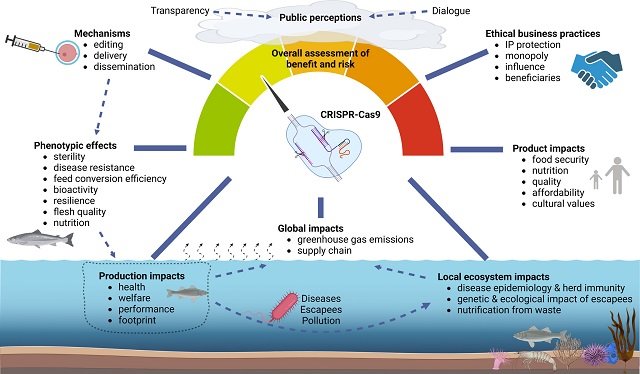
Challenges associated with aquaculture, such as animal welfare, production efficiency, and environmental sustainability, have led to the exploration of innovative solutions. One of these solutions is genetic editing using CRISPR-Cas9.
Scientists from Nofima, Deakin University, and the University of Edinburgh published a scientific review highlighting the benefits and risks of genetic editing in aquaculture.
They propose a general framework for the risk-benefit analysis of gene editing in the aquaculture industry, incorporating nine key considerations: genetic impacts, ecological impacts, disease risk mitigation, nature of editing, environmental supply chain footprint, animal welfare, human nutrition, ethical business implications, and impacts on local communities.
Genetic Editing Potential in Aquaculture
Genetic editing with CRISPR-Cas9 has the potential to revolutionize aquaculture by improving animal welfare, nutritional attributes, and production efficiency.
This technology enables precise modifications to the DNA of aquatic organisms, opening the door to creating species with enhanced traits. This could result in faster-growing fish, increased disease resistance, and improved nutritional composition, contributing to global food security.
Benefits of Genetic Editing
- Improved Animal Welfare: Genetic editing can reduce the suffering of aquatic organisms by creating healthier and more comfortable growth conditions.
- Production Efficiency: Genetically edited organisms can grow faster and require fewer resources, enhancing aquaculture efficiency.
- Environmental Sustainability: Genetic editing can reduce the need for chemicals and medications, decreasing environmental impact.
- Enhanced Nutritional Attributes: Food derived from genetically edited organisms can be richer in essential nutrients.
Technical, Social, Legal, and Commercial Challenges
The scientists emphasize that implementing genetic editing in food production systems (livestock, aquaculture, agriculture, etc.) is a complex process. In addition to technical challenges for production and implementation, there are significant social, legal, and commercial challenges associated with genetic editing and genetic modification.
“Applying CRISPR-Cas9 technology to aquaculture sectors could be a blessing or a curse, depending on the nature of the edits, the motivation, and the risk of harm resulting from the creation or exposure to edited species. Profitable production will be a driving motivation, but stakeholders must thoroughly assess the risks and benefits beyond mere economics,” the scientists report.
Despite its benefits, genetic editing also presents significant challenges and risks:
- Unintended Side Effects: Genetic modifications can have unforeseen effects on other characteristics of organisms.
- Genetic Introgression: Genetically edited organisms can interbreed with wild populations, leading to unpredictable consequences for ecosystems.
- Public Acceptance: Lack of understanding or misconceptions about genetic editing could lead to public opposition and stricter regulations.
Public Acceptance
According to the scientists, “Public acceptance is a key determinant for the successful application of gene editing in aquaculture, and all stakeholders will benefit from consumers viewing gene editing applications positively. To achieve public acceptance of genetic editing, or to provide an opportunity to reject the method’s implementation based on facts, effective science communication and research dissemination are necessary.“
They also emphasize that “scientists, industry, and regulators must work closely with indigenous communities to ensure that potential changes do not affect the cultural significance of species and their place in the environment.”
A Framework for Risk-Benefit Analysis
According to the study, the implementation of genetic editing in aquaculture is in its infancy, and scientific literature on the potential risks and benefits of this technology is scarce.
To address these challenges, scientists propose a comprehensive framework for the risk-benefit analysis of genetic editing in aquaculture. This framework incorporates nine key considerations:
- Genetic Impacts: Evaluate the impact on the genomes of organisms.
- Ecological Impacts: Study how modifications could affect aquatic ecosystems.
- Disease Risk Mitigation: Identify how genetic editing can reduce the spread of diseases.
- Nature of Editing: Understand the specificity and precision of genetic modifications.
- Environmental Supply Chain Footprint: Assess the environmental impact in production and distribution.
- Animal Welfare: Consider the welfare of cultivated organisms.
- Human Nutrition: Analyze how genetic editing affects the nutritional quality of products.
- Ethical Business Implications: Examine ethical issues related to the marketing of genetically edited products.
- Impacts on Local Communities: Consider how genetic editing may affect communities dependent on aquaculture.
Conclusion
Genetic editing in aquaculture has the potential to address many of the current challenges facing this industry. However, its implementation requires a rigorous assessment of benefits and risks, along with effective communication with the public.
The proposed framework provides guidance for making informed decisions on how to apply genetic editing in aquaculture, maximizing the benefits for food security, sustainability, and the well-being of all involved.
The study was funded by the Norwegian Seafood Research Fund and the Biotechnology and Biological Sciences Research Council.
Contact
Nicholas A. Robinson
Breeding and Genetics and Nutrition and Feed Technology
Nofima AS
PO Box 6122, 9291 Tromsø, Norway.
Email: nick.robinson@nofima.no
Reference (open access)
Robinson, NA, Østbye, T-KK, Kettunen, AH, et al. A guide to assess the use of gene editing in aquaculture. Rev Aquac. 2023; 1-10. doi:10.1111/raq.12866

